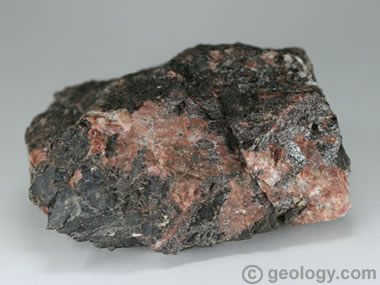Titanite - Also Known as Sphene
Titanite is a minor ore of titanium and a minor gemstone known as "sphene."
Article by: Hobart M. King, PhD

Titanite: A twinned crystal of titanite with adularia and clinochlore on matrix. The crystal is about one inch (2.5 centimeters) in height. From Tormiq Valley, Haramosh Mountains, Skardu District, Baltistan, Northern Areas, Pakistan. Specimen and photo by Arkenstone / www.iRocks.com.
What is Titanite?
Titanite is a rare titanium mineral that occurs as an accessory mineral in granitic and calcium-rich metamorphic rocks. It is a minor ore of titanium and a minor gemstone known as sphene.
Physical Properties of Titanite
Titanite's diagnostic properties are its crystal habit, color, and luster. Its monoclinic crystals are often wedge-shaped or tabular-shaped. Its typical color range is yellow, green, brown, and black. Pink, orange, and red specimens are rare.
Physical Properties of Titanite |
|
| Chemical Classification | Calcium titanium silicate. |
| Color | Commonly yellow, green, brown, black or gray. Rarely pink, red, or orange. |
| Streak | White. |
| Luster | Resinous to adamantine. |
| Diaphaneity | Translucent to transparent. |
| Cleavage | Fair to good. |
| Mohs Hardness | 5 to 5.5 |
| Specific Gravity | 3.4 to 3.6 |
| Diagnostic Properties | Luster, hardness, color, dispersion. |
| Chemical Composition | CaTiSiO5 |
| Crystal System | Monoclinic. |
| Uses | Minor ore of titanium. Minor gemstone. |
Titanite has a resinous to adamantine luster that is rarely seen in other minerals. It has one of the highest dispersions of any mineral - significantly higher than diamond. Titanite is also pleochroic. Transparent specimens might show its three trichroic colors.
Titanite is sometimes confused with sphalerite, especially when observing an adamantine to resinous luster. Sphalerite is softer than titanite, and often produces an odor of sulfur immediately after a streak test.

Titanite: Numerous titanite crystals on a specimen of schist. The large crystal is about 22 millimeters (one inch) in length. From Tormiq Valley, Haramosh Mountains, Skardu District, Baltistan, Northern Areas, Pakistan. Photo by Parent Gery, displayed here under a Creative Commons License.
"Titanite" or "Sphene"
Before 1982, the name "sphene" was common usage for this mineral. Then the International Mineralogical Association adopted the name "titanite" and discredited "sphene." Geologists and mineralogists worldwide quickly switched to the name "titanite" and it is now in common use. The name "sphene" is rarely seen in current publications.
The name "sphene" is still the dominant usage in the gem, jewelry, and lapidary industries. There, a name change can cause severe disruption in marketing gemstone and jewelry products.

Pink Titanite: Massive pink titanite from Westport, Ontario, Canada. Pink is a rare color for this mineral. Specimen is approximately 10 centimeters across.
Chemical Composition of Titanite
Titanite has a chemical composition of CaTiSiO5 and sometimes contains rare earth elements such as cerium, niobium, and yttrium. It can contain other elements such as aluminum, chromium, fluorine, iron, magnesium, manganese, sodium, and zirconium.
Iron has a strong influence on the color of titanite. Small amounts of iron darken the color. Yellow and green specimens have a low iron content, while brown and black specimens have a higher iron content.

The best way to learn about minerals is to study with a collection of small specimens that you can handle, examine, and observe their properties. Inexpensive mineral collections are available in the Geology.com Store. Image copyright iStockphoto / Anna Usova.
Geologic Occurrence of Titanite
Titanite is a rare mineral. It occurs as an accessory mineral in a few igneous rocks that include granite, granodiorite, diorite, syenite, and nepheline syenite. It is sometimes present in marble or calcium-rich gneiss and schist. It often occurs as individual grains. When abundant, its habit is usually granular to massive. The best crystals are usually found in marble.
Unlike other titanium minerals, titanite is rarely found in placer deposits. Its cleavage, parting, and a low hardness make it vulnerable to the abrasion of stream transport.

Sphene: A greenish yellow faceted sphene, back illuminated to show its very high dispersion. This 8 x 6 millimeter oval was cut from material mined in Pakistan.
Sphene the Gemstone
Sphene continues to be the name used for titanite in the gem and jewelry industries. It is a minor gemstone that is popular with collectors because of its high dispersion. Sphene is one of the few minerals with a dispersion higher than diamond. The dispersion of diamond is 0.044, while the dispersion of sphene is 0.051. Specimens of sphene with high clarity can display a strong, colorful fire when light is passed through them (see accompanying image).
Sphene is not commonly seen in jewelry. Its hardness of 5 to 5.5 on the Mohs scale, along with its easy cleavage and parting, make it too fragile as a ring stone. Reliable supplies of cut stones in commercial quantities have not been developed, and the jewelry-buying public is unfamiliar with the gem. For these reasons, sphene has not become a mainstream gem that is commonly available in jewelry.
| More Gemstones |
 |
Tourmaline |
 |
Fancy Sapphires |
 |
Diamond |
 |
Canadian Diamond Mines |
 |
Birthstones |
 |
Pictures of Opal |
 |
Fire Agate |
 |
Blue Gemstones |

Find Other Topics on Geology.com:

|

| ||

|

| ||

|

| ||

|

|
